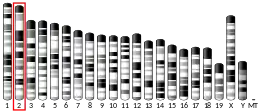| STMN3 | |||||||||||||||||||||||||||||||||||||||||||||||||||
|---|---|---|---|---|---|---|---|---|---|---|---|---|---|---|---|---|---|---|---|---|---|---|---|---|---|---|---|---|---|---|---|---|---|---|---|---|---|---|---|---|---|---|---|---|---|---|---|---|---|---|---|
| Identifiers | |||||||||||||||||||||||||||||||||||||||||||||||||||
| Aliases | STMN3, SCLIP, stathmin 3 | ||||||||||||||||||||||||||||||||||||||||||||||||||
| External IDs | OMIM: 608362 MGI: 1277137 HomoloGene: 7528 GeneCards: STMN3 | ||||||||||||||||||||||||||||||||||||||||||||||||||
| |||||||||||||||||||||||||||||||||||||||||||||||||||
| |||||||||||||||||||||||||||||||||||||||||||||||||||
| |||||||||||||||||||||||||||||||||||||||||||||||||||
| Wikidata | |||||||||||||||||||||||||||||||||||||||||||||||||||
| |||||||||||||||||||||||||||||||||||||||||||||||||||
Stathmin-3 is a protein that in humans is encoded by the STMN3 gene.[4][5][6]
Function
The protein encoded by this gene belongs to the stathmin/oncoprotein 18 family of microtubule-destabilizing phosphoproteins. It is similar to the SCG10 protein and is involved in signal transduction and regulation of microtubule dynamics.[6]
Interactions
References
- 1 2 3 GRCm38: Ensembl release 89: ENSMUSG00000027581 - Ensembl, May 2017
- ↑ "Human PubMed Reference:". National Center for Biotechnology Information, U.S. National Library of Medicine.
- ↑ "Mouse PubMed Reference:". National Center for Biotechnology Information, U.S. National Library of Medicine.
- ↑ Ozon S, Byk T, Sobel A (June 1998). "SCLIP: a novel SCG10-like protein of the stathmin family expressed in the nervous system". Journal of Neurochemistry. 70 (6): 2386–96. doi:10.1046/j.1471-4159.1998.70062386.x. PMID 9603203. S2CID 1252160.
- ↑ Bai C, Connolly B, Metzker ML, Hilliard CA, Liu X, Sandig V, Soderman A, Galloway SM, Liu Q, Austin CP, Caskey CT (February 2000). "Overexpression of M68/DcR3 in human gastrointestinal tract tumors independent of gene amplification and its location in a four-gene cluster". Proceedings of the National Academy of Sciences of the United States of America. 97 (3): 1230–5. Bibcode:2000PNAS...97.1230B. doi:10.1073/pnas.97.3.1230. PMC 15578. PMID 10655513.
- 1 2 "Entrez Gene: STMN3 stathmin-like 3".
- ↑ Greka A, Navarro B, Oancea E, Duggan A, Clapham DE (August 2003). "TRPC5 is a regulator of hippocampal neurite length and growth cone morphology". Nature Neuroscience. 6 (8): 837–45. doi:10.1038/nn1092. PMID 12858178. S2CID 7523946.
Further reading
- Gavet O, Ozon S, Manceau V, Lawler S, Curmi P, Sobel A (November 1998). "The stathmin phosphoprotein family: intracellular localization and effects on the microtubule network". Journal of Cell Science. 111 ( Pt 22) (22): 3333–46. doi:10.1242/jcs.111.22.3333. PMID 9788875.
- Charbaut E, Curmi PA, Ozon S, Lachkar S, Redeker V, Sobel A (May 2001). "Stathmin family proteins display specific molecular and tubulin binding properties". The Journal of Biological Chemistry. 276 (19): 16146–54. doi:10.1074/jbc.M010637200. PMID 11278715.
- Bièche I, Maucuer A, Laurendeau I, Lachkar S, Spano AJ, Frankfurter A, Lévy P, Manceau V, Sobel A, Vidaud M, Curmi PA (April 2003). "Expression of stathmin family genes in human tissues: non-neural-restricted expression for SCLIP". Genomics. 81 (4): 400–10. doi:10.1016/S0888-7543(03)00031-4. PMID 12676564.
- Greka A, Navarro B, Oancea E, Duggan A, Clapham DE (August 2003). "TRPC5 is a regulator of hippocampal neurite length and growth cone morphology". Nature Neuroscience. 6 (8): 837–45. doi:10.1038/nn1092. PMID 12858178. S2CID 7523946.
This article is issued from Wikipedia. The text is licensed under Creative Commons - Attribution - Sharealike. Additional terms may apply for the media files.

